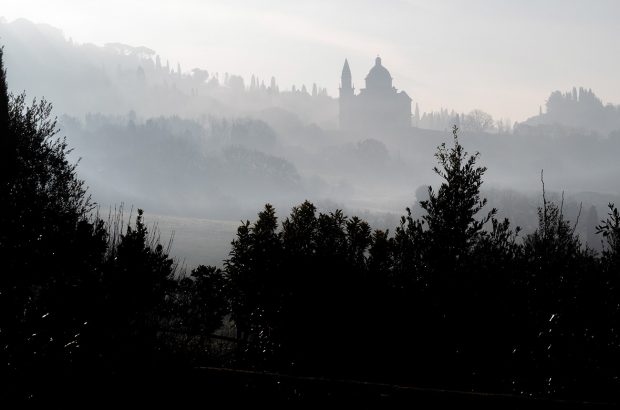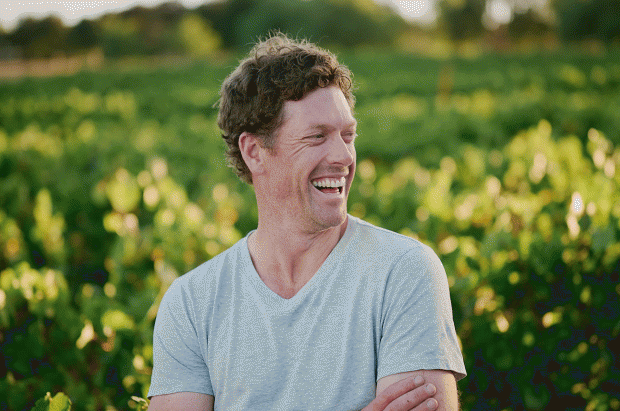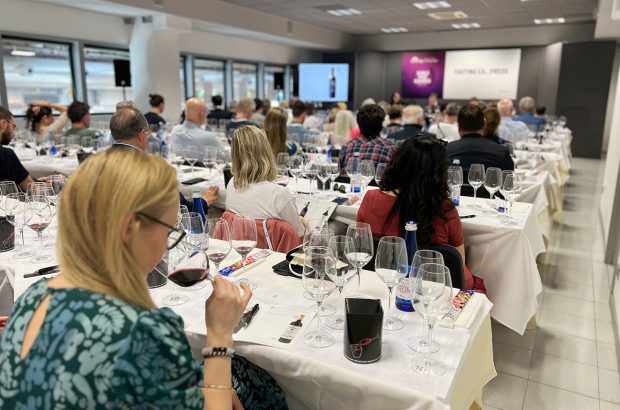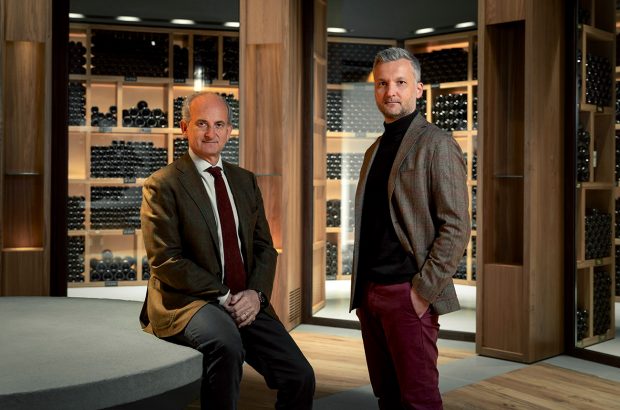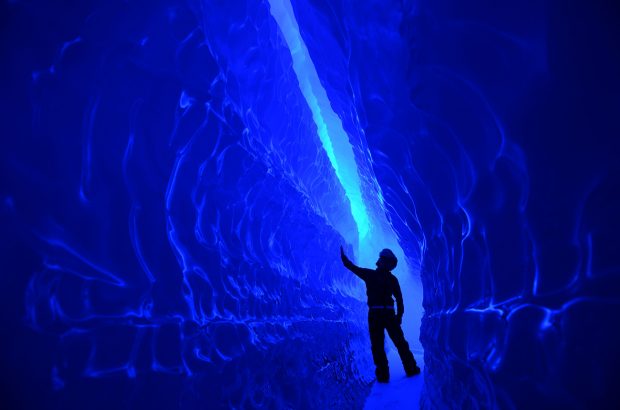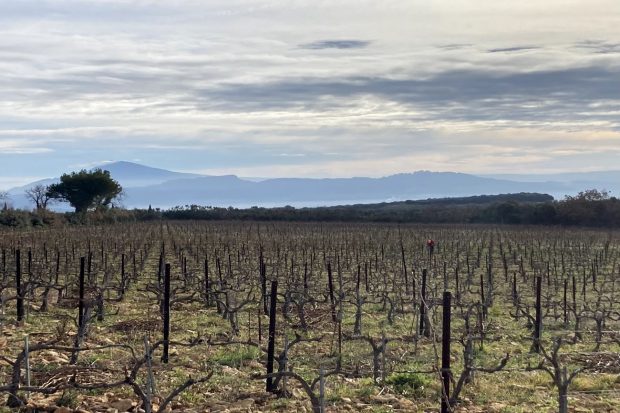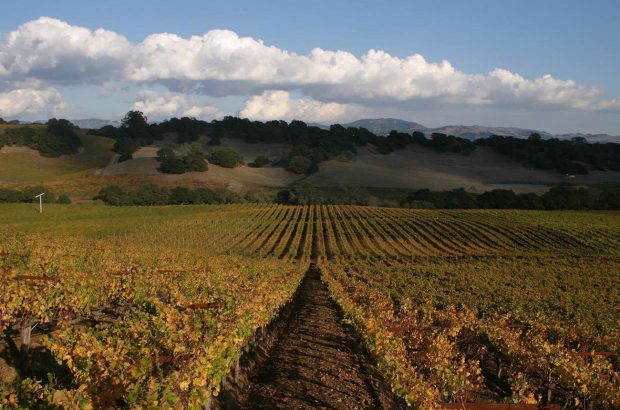Burgundy master Clive Coates MW tells you everything that you need to know about Domaine Jean Grivot, along with historical tasting notes on wines from top vintages - as part of a series that looks back at domaine profiles from Clive's most recent books.
I don’t like half bottles: stupid size. Not nearly enough for one – let alone two. But for some reason, lurking about in the Château Coates cellar, I owned a half of the Domaine Grivot’s Clos de Vougeot 1964. Eventually I opened it at the end of a boozy dinner. My friend said she’d take half a glass up to bed with her. I finished the washing up and relaxed with the rest. It was delicious.
But Etienne Grivot disagrees. He was born in 1959, and it never occurred to him that his role in life was not to follow his father Jean into the family domaine. But as he grew up, drinking the occasional bottle from years like 1929 and 1937, and wines from the great vintages immediately after the second world war, he began to realise that the wines the Grivot domaine was producing in the 1960s and 1970s were a shadow of their former selves.
Why? Because they were over-fertilising the vineyards, and as a teacher demonstrated to Etienne when he was doing his studies in the late 1970s (first a B.T. (Brevet Technique) in general agriculture, and then a B.T.S. (superior) in viticulture and oenology), the soil in Burgundy was becoming increasingly incapable of producing vins de terroir, wines which had the magic character and flavour concentration of where they come from.
The origins of the Grivot family lie in the upper reaches of the river Doubs, a hundred kilometres to the east in the Jura, but Grivots have been established in Burgundy since the French Revolution.
At first they lived in Nuits-Saint-Georges, farming vines at Arcenats in the Hautes-Côtes and at Corgoloin, but raising other crops as well. A branch then moved to Vosne-Romanée, and slowly but surely the activities of this side of the family concentrated on wine production.
Gaston Grivot, son of Joseph and father of Jean, sold his vines in these lesser areas in 1919 in order to buy an important piece of Clos Vougeot from a M. Polack. He was one of the first to pursue a proper oenological degree at Dijon university in the 1920s.
And he had the foresight to marry Madelaine, daughter of Émile Grivot of Nuits-Saint-Georges in 1927 – no close relation, but surely a distant cousin – who brought vines in Pruliers and Roncières with her as a dowry.
{"content":"PHA+SmVhbiBHcml2b3QsIHRoZSBwcmVzZW50IGhlYWQgb2YgdGhlIGZhbWlseSwgd2FzIGJvcm4gaW4gMTkyOC7CoCBIZSB0b28gc3R1ZGllZCBhdCBEaWpvbiwgbWFycmllZCBhIEpheWVyLCBZdm9ubmUsIGluaGVyaXRpbmcgdmluZXMgaW4gQ2hhbWJvbGxlLCBWb3NuZS1Sb21hbsOpZSwgTGVzIFJvdWdlcyBhbmQgw4ljaMOpemVhdXggZnJvbSBoZXIgYW5kIGhlciBzaXN0ZXIgSmFjcXVlbGluZSwgYW5kLCBpbiAxOTg0LCBhY3F1aXJlZCBhIHBhcmNlbCBvZiBsYW5kIGluIFJpY2hlYm91cmcsIGZvcm1lcmx5IG93bmVkIGJ5IHRoZSBWaWVub3QgZXN0YXRlLCBkaXZpZGluZyBpdCB3aXRoIEplYW4gTW9uZ2VhcmQuPC9wPgo8ZGl2IGNsYXNzPSJhZC1jb250YWluZXIgYWQtY29udGFpbmVyLS1tb2JpbGUiPjxkaXYgaWQ9InBvc3QtaW5saW5lLTMiIGNsYXNzPSJpcGMtYWR2ZXJ0Ij48L2Rpdj48L2Rpdj4KPHA+VGhlIHZpbmVzIGhlcmUgd2VyZSBub3QgaW4gdGhlIG1vc3QgcGVyZmVjdCBvZiBjb25kaXRpb25zLiBBbmQgaXQgdGFrZXMgdGltZSB0byBnZXQgdGhlbSBpbiBvcmRlci4gQnV0IHRoZSBtYWpvcml0eSBvZiB0aGUgdmluZXMgZGF0ZSBmcm9tIHRoZSBsYXRlIDE5MzBzLiBTaW5jZSAyMDA2IHRoZSB2aW5leWFyZCwgbGlrZSBvdGhlciBHcml2b3QgbGFuZCBpbiBWb3NuZS1Sb21hbsOpZSBoYXMgYmVlbiBwbG91Z2hlZCBieSBhIGhvcnNlLCBQaXJhdGUuIFNlZSB0aGUgdGFzdGluZyBub3RlcyBiZWxvdy48L3A+CjxwPkxpdHRsZSBieSBsaXR0bGUsIHRoZXJlZm9yZSwgYSBzaXplYWJsZSAoYnkgQnVyZ3VuZGlhbiBzdGFuZGFyZHMpIGRvbWFpbmUgaGFzIGJlZW4gY3JlYXRlZC7CoCBUaGVyZSBhcmUgY3VycmVudGx5IDQwIHBhcmNlbHMgb2YgdmluZXMgc3ByZWFkIG92ZXIgMTQuOCBoZWN0YXJlcy7CoCBBbmQgMjIgZGlmZmVyZW50IHdpbmVzLsKgIEZyb20gMTk1OSBhbGwgaGFzIGJlZW4gc29sZCBpbiBib3R0bGUuQXMgZWFybHkgYXMgMTk3OCBFdGllbm5lIHBlcnN1YWRlZCBoaXMgZmF0aGVyIHRvIGFiYW5kb24gY2hlbWljYWwgZmVydGlsaXNhdGlvbi48L3A+CjxkaXYgY2xhc3M9ImFkLWNvbnRhaW5lciBhZC1jb250YWluZXItLW1vYmlsZSI+PGRpdiBpZD0icG9zdC1pbmxpbmUtNCIgY2xhc3M9ImlwYy1hZHZlcnQiPjwvZGl2PjwvZGl2Pgo8cD5IZSBkaWRu4oCZdCBqb2luIHRoZSBkb21haW5lIHVudGlsIGFmdGVyIGhl4oCZZCBmaW5pc2hlZCBoaXMgbWlsaXRhcnkgc2VydmljZSBpbiAxOTgxLsKgIEJ1dCByaWdodCBmcm9tIHRoZSBiZWdpbm5pbmcgaGUgcGVyc3VhZGVkIEplYW4gR3Jpdm90IHRvIGxldCBoaW0gdGFrZSBjaGFyZ2Ugb2YgYXQgbGVhc3Qgb25lIHdpbmUuwqAgR3JhZHVhbGx5IG92ZXIgdGhlIGRlY2FkZSBoZSB0b29rIG92ZXIuPC9wPgo8cD7igJxJIHNlZSB0aGUgZXZvbHV0aW9uIG9mIERvbWFpbmUgR3Jpdm90IGluIGZvdXIgcGhhc2VzLOKAnSBoZSBzYXlzLsKgIOKAnEJldHdlZW4gMTk4MiBhbmQgMTk4NiBJIGZvcmdlZCBteSBvcGluaW9ucy7CoCBJIHRhbGtlZCBhbmQgdGFzdGVkIHdpdGggbXkgZnJpZW5kcyBhbmQgY29udGVtcG9yYXJpZXMsIGFtb25nIHRoZW0gRG9taW5pcXVlIExhZm9uIGFuZCBDaHJpc3RvcGhlIFJvdW1pZXIuwqAgV2Ugd2VyZSBhbGwgaW4gdGhlIHByb2Nlc3Mgb2YgdGFraW5nIG92ZXIgd2VsbC1yZXB1dGVkIGVzdGF0ZXMsIGJ1dCB3ZSBhbGwgZmVsdCB3ZSBjb3VsZCBhbmQgc2hvdWxkIGltcHJvdmUgdGhpbmdzLuKAnTwvcD4KPGRpdiBjbGFzcz0iYWQtY29udGFpbmVyIGFkLWNvbnRhaW5lci0tbW9iaWxlIj48ZGl2IGlkPSJwb3N0LWlubGluZS01IiBjbGFzcz0iaXBjLWFkdmVydCI+PC9kaXY+PC9kaXY+CjxwPkl0IHdhcyBhdCB0aGlzIHBlcmlvZCB0aGF0IGhlIG1ldCBNYXJpZWxsZSBCaXplLCB0aGUgdGFsbCwgZWxlZ2FudCwgc2xlbmRlciwgeW91bmdlciBzaXN0ZXIgb2YgUGF0cmljaywgb2YgRG9tYWluZSBTaW1vbiBCaXplIGluIFNhdmlnbnktTMOocy1CZWF1bmUuwqAg4oCcUGF0cmljayzigJ0gc2F5cyBFdGllbm5lLCDigJxhc2tlZCBpZiBoZSBjb3VsZCBjb21lIHRvIHRhc3RlIHdpdGggYSBjbGllbnQuwqAgTGF0ZXIsIEkgd2VudCBiYWNrIHRvIHNhbXBsZSBoaXMgd2luZXMuwqAgSSBzYXcgTWFyaWVsbGUuwqAgVGhpcyBpcyB0aGUgd29tYW4gSSB3YW50IHRvIG1hcnJ5LCBJIHNhaWQgdG8gbXlzZWxmLuKAncKgIFRoZXkgd2VyZSBtYXJyaWVkIGluIDE5ODcsIGFuZCBoYXZlIHR3byBjaGlsZHJlbi7CoCBNYXRoaWxkZSwgYm9ybiAxOTg5LCBhbmQgYW4gaW50ZXJuYXRpb25hbCBldmVudGVyLCBhbmQgSHViZXJ0LCBib3JuIGluIDE5OTEsIGRlc3RpbmVkIHRvIHRha2Ugb3ZlciwgZXZlbnR1YWxseSwgZnJvbSBoaXMgZmF0aGVyLjwvcD4KPHA+UGhhc2UgdHdvIGJlZ2lucyB3aXRoIGhpcyBpbnRyb2R1Y3Rpb24gdG8gR3V5IEFjY2FkLsKgIOKAnEFjY2FkIHdhcyBpbmNvbXBldGVudCBhcyBhIGNvbW11bmljYXRvciwgcnVkZSBhbmQgdW5nYWlubHkgYXMgYW4gaW5kaXZpZHVhbCwgYnV0IGEgZ2VuaXVzIHdoZW4gaXQgY2FtZSB0byBzb2lsIGFuYWx5c2lzIGFuZCB3aGF0IHdhcyB2aXRhbCB0byBkbyB0byByZWdlbmVyYXRlIHRoZSBsaWZlIHRoZXJlaW46IGhvdyB0byBwZXJzdWFkZSB0aGUgdmluZXMgdG8gZ2V0IHRoZSBtYXhpbXVtIG91dCBvZiB0aGVpciBlbnZpcm9ubWVudC7CoCBIZSBhbHNvIGhhZCB2ZXJ5IGRlZmluaXRlIHZpZXdzIG92ZXIgdmluaWZpY2F0aW9uLsKgIEFuZCBpdCBpcyBoZXJlIHRoYXQgdGhlIGNvbnRyb3ZlcnN5IGxpZXMu4oCdPC9wPgo8cD5JdCBpcyBkaWZmaWN1bHQgdG8gYXBwcmVjaWF0ZSB0b2RheSBob3cgb3JpZ2luYWwgR3V5IEFjY2FkIHdhcyBhdCB0aGUgdGltZS7CoCBBbG9uZ3NpZGUgQ2xhdWRlIEJvdXJndWlnbm9uIGFuZCBoaXMgZ3JvdW5kLWJyZWFraW5nIGJvb2s6IExlIFNvbCwgTGEgVGVycmUgZXQgTGVzIENoYW1wcywgQWNjYWQgd2FzIHRoZSBmaXJzdCB0byBkZW1vbnN0cmF0ZSB0aGUgaW1wb3J0YW5jZSBvZiB0aGUgdmluZXPigJkgZW52aXJvbm1lbnQgYW5kIHRoZSByb2xlIGl0IGhhZCB0byBwbGF5LjwvcD4KPHA+QnV0IEFjY2FkIHdhcyBhbHNvIGEgc3Ryb25nIGFkdm9jYXRlIG9mIGxvbmcsIGluZGVlZCBwcm9sb25nZWQsIGNvbGQtc29ha2luZyBiZWZvcmUgdmluaWZpY2F0aW9uLsKgIFRoaXMgb2NjdXJyZWQgbmF0dXJhbGx5IGluIHRoZSBvbGQgZGF5cywgd2hlbiBoYXJ2ZXN0cyB0b29rIHBsYWNlIGluIE9jdG9iZXIsIGZvciB0aGUgZ3JhcGVzIHdlcmUgZ2F0aGVyZWQgYXQgMTDCsEMgYW5kIGl0IHRvb2sgYSB3ZWVrIGZvciB0aGUgZmVybWVudGF0aW9ucyB0byBnZXQgdW5kZXJ3YXkuPC9wPgo8cD5CdXQgaXQgZGlkIG5vdCBwcm9kdWNlIHRoZSBzdWNjdWxlbnQsIGp1aWN5LCBlYXN5IHRvIGFwcHJlY2lhdGUgd2luZXMgW3RoYXRdIGNyaXRpY3MgYW5kIGJ1eWVycyBsaWtlZCB0byBmaW5kIHdoZW4gdGhleSBzYW1wbGVkIHRoZW0gaW4gY2FzaywgZXNwZWNpYWxseSBpZiB5b3UgZm9sbG93ZWQgdGhlIEFjY2FkIGVkaWN0IHRvIGJsb2NrIHRoZSBvbnNldCBvZiB0aGUgZmVybWVudGF0aW9uIGZvciBhIHdlZWsgb3IgbW9yZS48L3A+CjxwPuKAnE15IGZhdGhlciB3YXMgYWxsIGluIGZhdm91cizigJ0gc2F5cyBFdGllbm5lLsKgIOKAnFRoZSB3aW5lcyBJIGJlZ2FuIHRvIHByb2R1Y2UgcmVtaW5kZWQgaGltIG9mIHRob3NlIG9mIGhpcyB5b3V0aC7CoCBJIHRvbyB3YXMgdXR0ZXJseSBjb252aW5jZWQgdGhhdCBteSAxOTg3cywgbm90IGFuIGVhc3kgdmludGFnZSwgd2VyZSBkaXN0aW5jdGx5IHN1cGVyaW9yIHRvIG1vc3Qgb2YgbXkgZnJpZW5kcy4gQnV0IHRoZXkgdGFzdGVkIG9kZCwgZGlmZmVyZW50LCBhbmQgYWxtb3N0IGV2ZXJ5b25lIGZvdW5kIHRoZW0gdW4tQnVyZ3VuZGlhbi7igJ08L3A+CjxwPkhlIHN0aWxsIHJhbmtsZXMgYXQgd2hhdCBoZSBzZWVzIGFzIHRoZSB1bmp1c3QgZGVzZXJ0aW9uIGhlIGV4cGVyaWVuY2VkIGZvbGxvd2luZyBoaXMgZmlyc3QgZmV3IEFjY2FkIHZpbnRhZ2VzLCBhbmQgdGhlIGZhY3QgdGhhdCBoZSB3YXMgbGVmdCwgYXMgdGhlIG1vc3QgcHJvbWluZW50IEFjY2FkaWFuLCB0byBqdXN0aWZ5IGFsbCB0aGUgQWNjYWQgd2luZXMsIGdvb2Qgb3IgYmFkLjwvcD4KPHA+4oCcSW4gZmFjdCBJIGJlZ2FuIHRvIGZlZWwgSSB3YXMgdGhlIG9ubHkgb25lIG1ha2luZyA8ZW0+YmFkIDwvZW0+d2luZSBpbiB0aGUgMTk4Ny0xOTkyIHBlcmlvZC7CoCBXZSBhbHNvIGxvc3QgdGhyZWUtcXVhcnRlcnMgb2Ygb3VyIGNsaWVudHMuPC9wPgo8cD7igJxHcmFkdWFsbHkgSSBiZWdhbiB0byBtb2RpZnksIHRvIHRha2UgdGhlIGJlc3Qgb2YgQWNjYWQgKHdlIGFyZSBzdGlsbCBmcmllbmRzLCBhbmQgSSB3b3VsZCB0cnVzdCBubyBvbmUgZWxzZSB0byBkbyBteSBzb2lsIGFuYWx5c2lzKSBhbmQgamV0dGlzb24gdGhlIHJlc3QuwqAgSSB3YW50ZWQgdGhlIGxpYmVydHkgdG8gbWFrZSBHcml2b3Qgd2luZXMsIG5vdCBBY2NhZCB3aW5lcy7CoCBUaGlzIGJlZ2FuIGluIDE5OTMu4oCdPC9wPgo8cD5UaGUgZm91cnRoIHBoYXNlIGZvbGxvd2VkIG9uIGxvZ2ljYWxseS7CoCBJbiAxOTk4IEV0aWVubmUgYmVnYW4gdG8gbWFrZSBzb21ld2hhdCBtb3JlIGdlbmVyb3VzIHdpbmVzLsKgIOKAnEl0IHdhcyBJIHdobyBoYWQgY2hhbmdlZC7CoCBJIHdhcyBhcHByb2FjaGluZyA0MDsgbW9yZSBtYXR1cmU7IG1vcmUgcmVsYXhlZC7CoCBUaGUgd2luZXMgYmVjYW1lIG1vcmUgc2VyZW5lIGFuZCBzdXBwbGUsIHdpdGhvdXQgY29tcHJvbWlzaW5nIHRoZWlyIGZyZXNobmVzcyBhbmQgcG90ZW50aWFsIHRvIGFnZSwgYmVjYXVzZSBJIHdhcyBtb3JlIGF0IGVhc2Uu4oCdPC9wPgo8cD5IZSBiZWdhbiB2aW5pZnlpbmcgYXQgYSBzbGlnaHRseSBoaWdoZXIgdGVtcGVyYXR1cmUsIDMxwrAgcmF0aGVyIHRoYW4gMjjCsC4gVGhlIHdpbmVzIGJlY2FtZSBsZXNzIG1vbm9saXRoaWMuPC9wPgo8cD4mIzgyMjE7TGV0IHRoZSB3aW5lIG1ha2UgaXRzZWxmLCBwYXJ0aWN1bGFybHkgaW4gdGhlIGJldHRlciB5ZWFyc+KAnS4gQW5kLCAod2hpY2ggd2UgZGlkbuKAmXQgdG91Y2ggb24pIGJlY2F1c2Ugb2YgYSBkZWNhZGUgb2YgQWNjYWQgdGVjaG5pcXVlcyBpbiB0aGUgdmluZXlhcmQgd2FzIG5vdyByZXN1bHRpbmcgaW4gYmV0dGVyIGZydWl0IGZyb20gbW9yZSDigJxncm93biB1cOKAnSB2aW5lcy4gR3JhZHVhbGx5IGhlIGNlYXNlZCB0aGUgdXNlIG9mIGluc2VjdGljaWRlcyBhbmQgaGVyYmljaWRlcy4gR3JhZHVhbGx5IHRoZSBkb21haW5lIGJlY2FtZSB0b3RhbGx5IGJpb2xvZ2ljYWwuIFNpbmNlIHRoZW4gdGhlIEdyaXZvdCB3aW5lcyBoYXZlIGJlZW4gdHJ1bHkgZXhjZWxsZW50LjwvcD4KPHA+SXQgd2FzIHdpdGggdGhlIDE5OTggdmludGFnZSwgY28taW5jaWRlbnRhbGx5LCB0aGF0IHRoZSBJbnN0aXR1dGUgb2YgTWFzdGVycyBvZiBXaW5lIGluIExvbmRvbiBjb21tZW5jZWQgYW4gYW5udWFsIEJ1cmd1bmR5IHRhc3Rpbmcgc3BvbnNvcmVkIGJ5IHRoZSBEb21haW5lcyBGYW1pbGlhdXggZXQgVHJhZGl0aW9uLCBhIGdyb3VwIG9mIHRvcCBlc3RhdGVzLsKgIEdyaXZvdCBzZW5kcyBhbG9uZyBoaXMgVm9zbmUtUm9tYW7DqWUsIExlcyBCZWF1bW9udHMgYW5kIHNvbWV0aW1lcyBzb21ldGhpbmcgZWxzZS7CoCBJdCBpcyBjb25zaXN0ZW50bHkgYW1vbmcgdGhlIHRvcCB0aHJlZSB3aW5lcyBvbiB0aGUgdGFibGUuPC9wPgo8cD5XaGF0IG9mIHRoZSBmdXR1cmU\/wqAg4oCcT25lIGlzIG5ldmVyIHNhdGlzZmllZC7CoCBUaGlzIGlzIGFuIG9ic2Vzc2lvbjogdG8gaW1wcm92ZS7CoCBBbmQgSSBkb27igJl0IHRoaW5rIEkgd2lsbCBldmVyIGdpdmUgdXAuwqAgSSBjZXJ0YWlubHkgZG9u4oCZdCBoYXZlIHRvIGZvciBtYW55LCBtYW55IHllYXJzLsKgIEnigJltIGhhcmRseSA1MC7CoCBBbmQgSHViZXJ0IGlzIHN0aWxsIGEgeW91bmcgbWFuLsKgIExpa2UgbWUsIGhlIGlzIGFzc3VtaW5nIHRoYXQgb25lIGRheSBoZSB3aWxsIHRha2Ugb3Zlci7CoCBCdXQgbm9ib2R54oCZcyBpcyBmb3JjaW5nIGFueXRoaW5nIG9uIGhpbS48L3A+CjxwPuKAnEJ1dCB3ZSBhbGwgbmVlZCBjaGFuZ2VzLsKgIENoYW5nZXMgb2Ygc2NlbmUgYW5kIG9jY3VwYXRpb24uwqAgSSBuZWVkIGZyZXNobmVzcy7CoCBJ4oCZbSBhIHZlcnkgY3VyaW91cyBwZXJzb24uwqAgSSBkb27igJl0IHVuZGVyc3RhbmQgdGhvc2Ugb2YgbXkgY29sbGVhZ3VlcyB3aG8gbmV2ZXIgdGFrZSBhIGhvbGlkYXkuwqAgVGhhdOKAmXMgYWJzdXJkLsKgIFdlIGdvIHRvIENhbmFkYSAodGhlIEdyaXZvdHMgaGF2ZSBhIGhvdXNlIG9uIExha2UgTWFzc29uLCBhYm91dCBhbiBob3VyIGF3YXkgZnJvbSBNb250cmVhbCkgZXZlcnkgc3VtbWVyIGZvciB0aHJlZSBvciBmb3VyIHdlZWtzLsKgIE9uZSBnZXRzIGJhY2sgcmVnZW5lcmF0ZWQuJiM4MjIxOyBIZSBhbHNvIGZsaWVzIGhlbGljb3B0ZXJzLjwvcD4KPHA+4oCcRG8gSSBoYXZlIGEgcGhpbG9zb3BoeSBvZiB3aW5lP8KgIExldOKAmXMgbWFrZSBhIHBhcmFsbGVsLsKgIDxlbT5UZXJyb2lyPC9lbT4gaXMgbGlrZSB3aGF0IGEgY29tcG9zZXIgb2YgbXVzaWMgaGFzIGNyZWF0ZWQuwqAgVGhlIHdpbmVtYWtlciBpcyBsaWtlIHRoZSBjb25kdWN0b3IuwqAgWW91IGhhdmUgZmluZSA8ZW0+dGVycm9pcnM8L2VtPiwgbGlrZSBncmVhdCBwaWVjZXMgb2YgbXVzaWMuwqAgQnV0IHlvdSBuZWVkIGEgZmluZSBpbnRlcnByZXRlci7CoCBJbiBmYWN0IGJlaW5nIGEgd2luZW1ha2VyIGhhcyBhIGxvdCBpbiBjb21tb24gd2l0aCBiZWluZyBhIGNvbmR1Y3Rvci7CoCBUaG91Z2ggSSB3b3VsZG7igJl0IGRlc2NyaWJlIG15c2VsZiBhcyBlc3BlY2lhbGx5IHBhc3Npb25hdGUgYWJvdXQgbXVzaWMsIEkgd291bGQgbGlrZSB0byBoYXZlIGJlZW4gYSBjb25kdWN0b3IuwqAgVGhlIHBvd2VyIG9mIGJlaW5nIGluIGNoYXJnZSBpbnRyaWd1ZXMgbWUuPC9wPgo8cD7igJxBcyBmYXIgYXMgd2luZW1ha2luZyBpcyBjb25jZXJuZWQgSeKAmW0gbG9va2luZyBmb3IgaGFybW9ueSBhbmQgYmFsYW5jZTogZnJlc2huZXNzIGlzIHByaW1vcmRpYWwuwqAgSSBkb27igJl0IHdhbnQgd2luZXMgd2hpY2ggYXJlIHRvbyBzcG9udGFuZW91cy7CoCBJIGxpa2UgYSB3aW5lIHdoaWNoIGlzIHNsb3cgdG8gZGV2ZWxvcC4gV2hhdCBJIGhhdmUgbGVhcm50IG92ZXIgdGhlIHllYXJzIGlzIHRoYXQgc29tZSB2aW50YWdlcyBuZWVkIGZlcm1lbnRpbmcgYXQgYSBkaWZmZXJlbnQgdGVtcGVyYXR1cmUgdG8gb3RoZXJzLjwvcD4KPHA+4oCcQXQgRG9tYWluZSBHcml2b3Qgd2UgZGUtc3RlbSAxMDAgcGVyY2VudDsgd2UmIzgyMTc7dmUgaGFkIGEgc29ydGluZyB0YWJsZSBzaW5jZSAyMDAwOyB0aGVyZSBpcyBjb2xkLXNvYWtpbmcsIGJ1dCBub3QgaW4gc3VjaCBhbiBleGFnZ2VyYXRlZCB3YXkgYXMgYmVmb3JlOyB3ZSB1c2UgYW55dGhpbmcgZnJvbSAyMCB0byA4MCBwZXJjZW50IG5ldyBvYWs7IGluIG91ciBjb2xkIGNlbGxhcnMgdGhlIG1hbG9zIGFyZSBvZnRlbiBsYXRlIHRvIGNvbXBsZXRlOyBhbmQgd2UgYm90dGxlIGFmdGVyIDE4IG1vbnRocyB3aXRob3V0IGZpbmluZ8KgICYjODIxMTsgZXhjZXB0IG9uIHRoZSByYXJlIG9jY2FzaW9ucyB3aGVuIGl0IGlzIG5lY2Vzc2FyeSAmIzgyMTE7wqAgYW5kLCBzaW5jZSAxOTg4LCB3aXRob3V0IGZpbHRyYXRpb24uwqAgQXJlIHdlIGxhdGUgb3IgZWFybHkgcGlja2Vycz\/CoCBOZWl0aGVyLsKgIEkgcGljayB3aGVuIEkgdGhpbmsgaXQgaXMgdGhlIHJpZ2h0IHRpbWUuwqAgQnV0IEkgaGF0ZSA8ZW0+c3VyLW1hdHVyaXTDqS4gPC9lbT5XaGF0IG15IG5laWdoYm91cnMgZG8gZG9lc27igJl0IGNvbmNlcm4gbWUuwqAgTXkgMTk5N3MgYXJlIHZlcnkgZmluZSBiZWNhdXNlIEkgcGlja2VkIHZlcnkgZWFybHksIHRvIHByZXNlcnZlIHRoZSBmcmVzaG5lc3Mu4oCdPC9wPgo8cD5FdGllbm5lIEdyaXZvdCBpcyB0YWxsIGFuZCBmaXQsIGFuIGF0dHJhY3RpdmUgbG9va2luZyBtYW4sIGdlbnRseSBncmV5aW5nLCBpbnRlbGxpZ2VudCBhbmQgdGhvdWdodGZ1bC7CoCAoSW4gdGhlIDE5ODBzIEkgd3JvdGUgYSBwaWVjZSBvbiBWb3NuZS1Sb21hbsOpZSBncm93ZXJzIGZvciBhbiBBbWVyaWNhbiB3aW5lIG1hZ2F6aW5lLCBXaW5lIE5ld3MuwqAgRXRpZW5uZSB3YXMgZmVhdHVyZWQgb24gdGhlIGNvdmVyLsKgIEhlIHJlY2VpdmVkIHNldmVyYWwgcHJvcG9zYWxzIG9mIG1hcnJpYWdlISk8L3A+CjxwPlRoaXMgR3Jpdm90IGlzIG5vdCwgeW91IHdvdWxkIHRoaW5rLCBlYXNpbHkgYXJvdXNlZCAod2hpY2ggaXMgbm90IGZvciBhIG1pbnV0ZSB0byBzdWdnZXN0IGhlIGxhY2tzIHBhc3Npb24uwqAgSGXigJlzIGp1c3QgZ290IGl0IHVuZGVyIGNvbnRyb2wpLsKgIEhlIG9ubHkgb25jZSBnb3QgcmVhbGx5IGJlbGxpZ2VyZW50IGR1cmluZyBvdXIgY29udmVyc2F0aW9uLsKgIEJhY2sgaW4gdGhlIGVhcmx5IDE5OTBzLCBhcyBJIGtuZXcsIHRoZSBJTkFPIGhhZCBhc2tlZCBoaW0gdG8gZXhwZXJpbWVudCB3aXRoIGEgY29uY2VudHJhdGluZyBtYWNoaW5lLsKgIFdoYXQgZGlkIGhlIHRoaW5rIG9mIHRoZW0uwqAgSGUgaXMgZnVuZGFtZW50YWxseSBhZ2FpbnN0LsKgIOKAnFRoZXkgZGVzdHJveSB0aGUgaGFybW9ueSBvZiB0aGUgd2luZXM6IGFsbCB0aGUgd2luZXMgdGFzdGUgdGhlIHNhbWU7IHRoZXkgYXJlIGJhbmFsIeKAnTwvcD4KPHA+SSB0aGluayB0aGVyZSBpcyBub3cgYSBmaWZ0aCBwaGFzZSBhcHBhcmVudCBhdCB0aGUgR3Jpdm90IGRvbWFpbmUuIFRoZSB3aW5lcyBzaW5jZSAyMDA1IG9yIHNvIGFyZSBldmVuIG1vcmUgcmVsYXhlZCDigJMgbGVzcyBpbnRyb3ZlcnRlZCwgYXMgRXRpZW5uZSB3b3VsZCBwdXQgaXQuIEFuZCBldmVuIG1vcmUgZGlzdGluY3RpdmUgYW5kIHByb2ZvdW5kLjwvcD4KPGRpdiBjbGFzcz0iYnJlYWtvdXQgcGFsZXR0ZS1hIHBhbmVsIHBhbmVsLWRlZmF1bHQiPjxkaXYgY2xhc3M9InBhbmVsLWJvZHkiPjxkaXYgY2xhc3M9J2JyZWFrb3V0LWNvbnRlbnQnPjwvcD4KPGgzPgo8c3Ryb25nPlRoZSBHcml2b3QgZG9tYWluZSBjdXJyZW50bHkgaW5jbHVkZXM8L3N0cm9uZz46PC9oMz4KPHA+PHN0cm9uZz5HcmFuZHMgQ3J1czogPC9zdHJvbmc+UmljaGVib3VyZyAoMzIgYSk7IENsb3MgZGUgVm91Z2VvdCAoMS44NiBoYSk7IEVjaMOpemVhdXggKDg1IGEpLjwvcD4KPHA+PHN0cm9uZz5Wb3NuZS1Sb21hbsOpZSBQcmVtaWVyIENydTwvc3Ryb25nPiBpbiBMZXMgQmVhdW1vbnRzLCBMZXMgQnJ1bMOpZXMsIExlcyBDaGF1bWVzLCBMZXMgUmVpZ25vdHMsIExlcyBSb3VnZXMgYW5kIExlcyBTdWNob3RzLjwvcD4KPHA+PHN0cm9uZz5OdWl0cy1TYWludC1HZW9yZ2VzIFByZW1pZXIgQ3J1PC9zdHJvbmc+IGluIExlcyBCb3Vkb3RzLCBMZXMgUHJ1bGllcnMgYW5kIExlcyBSb25jacOocmVzLjwvcD4KPHA+PHN0cm9uZz5WaWxsYWdlIFZvc25lLVJvbWFuw6llPC9zdHJvbmc+IGluY2x1ZGluZyBMZXMgQm9zc2nDqHJlcy48L3A+CjxkaXYgY2xhc3M9ImluamVjdGlvbiI+PC9kaXY+CjxwPjxzdHJvbmc+VmlsbGFnZSBOdWl0cy1TYWludC1HZW9yZ2VzPC9zdHJvbmc+IGluY2x1ZGluZyBMZXMgQ2hhcm1vdHMgYW5kIExlcyBMYXZpw6hyZXMuPC9wPgo8cD48c3Ryb25nPlZpbGxhZ2UgQ2hhbWJvbGxlLU11c2lnbnk8L3N0cm9uZz4gTGEgQ29tYmUgZCYjODIxNztPcnZlYXV4LjwvcD4KPHA+CjwvZGl2PjxkaXYgY2xhc3M9J2JyZWFrb3V0LWJ1dHRvbnMnPjxkaXYgY2xhc3M9J3Jvdyc+PC9kaXY+PC9kaXY+PC9kaXY+PC9kaXY+CjxwPkFzIEkgYmVnaW4gdG8gdGFrZSBteSBsZWF2ZSBJIGFzayBoaW0gb25lIG1vcmUgcXVlc3Rpb24uwqAgRG8geW91IGhhdmUgYSBmcnVzdHJhdGVkIGFtYml0aW9uLCBFdGllbm5lP8KgIEhlIHRoaW5rcyBmb3IgYSBtaW51dGUuwqAg4oCcSSB3b3VsZCBoYXZlIGxpa2VkIHRvIGhhdmUgYmVlbiBzb21lb25lIHJlYWxseSBmYW1vdXMu4oCdPC9wPgo8cD5CdXQgaW4gdGhlIHdpbmUgd29ybGQgeW91IGFyZSwgRXRpZW5uZS7CoCBZb3UgcmVhbGx5IGFyZS48L3A+Cjxocj4KPHA+Cg=="}
See Clive’s wine ratings for top vintages
{}
{"wineId":"19408","displayCase":"standard","paywall":true}
{"wineId":"19406","displayCase":"standard","paywall":true}
{"wineId":"19407","displayCase":"standard","paywall":true}
{"wineId":"19398","displayCase":"standard","paywall":true}
{"wineId":"19400","displayCase":"standard","paywall":true}
{}
Where to buy Clive Coates MW’s ‘My Favorite Burgundies’ book:






